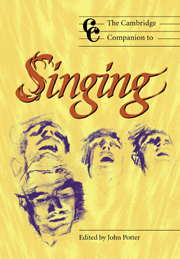Book contents
- Frontmatter
- 1 Introduction: singing at the turn of the century
- Part I Popular traditions
- Part II The voice in the theatre
- Part III Choral music and song
- Part IV Performance practices
- 12 Some notes on choral singing
- 13 Ensemble singing
- 14 The voice in the Middle Ages
- 15 Reconstructing pre-Romantic singing technique
- 16 Alternative voices: contemporary vocal techniques
- 17 The teaching (and learning) of singing
- 18 Children's singing
- 19 Where does the sound come from?
- Notes
- Select bibliography
- Index
16 - Alternative voices: contemporary vocal techniques
from Part IV - Performance practices
Published online by Cambridge University Press: 28 September 2011
- Frontmatter
- 1 Introduction: singing at the turn of the century
- Part I Popular traditions
- Part II The voice in the theatre
- Part III Choral music and song
- Part IV Performance practices
- 12 Some notes on choral singing
- 13 Ensemble singing
- 14 The voice in the Middle Ages
- 15 Reconstructing pre-Romantic singing technique
- 16 Alternative voices: contemporary vocal techniques
- 17 The teaching (and learning) of singing
- 18 Children's singing
- 19 Where does the sound come from?
- Notes
- Select bibliography
- Index
Summary
Composers very often write music with specific performers in mind. Performers' particular gifts, perhaps an outstanding technique or an individual quality of interpretation, can stimulate and open up a composer's imagination. The written-out ornamentation Monteverdi supplied for Orpheus's central aria ‘Possente spirto’ in Orfeo poses a technical challenge which suggests why its likely first singer, Francesco Rasi, was so admired by his contemporaries. In our own century, Poulenc's intuitive response in setting the difficult poetry of Apollinaire and Eluard was also shaped by his experience of Pierre Bernac's sensitive projection of texts. The genesis of these examples, both of which belong firmly to the ‘traditional’ rather than the ‘alternative’ vocal tradition, only reinforces the point that very many alternative developments come out of the creative nexus between composer and intended interpreter. So even though most of today's alternative voices sound more radical to an audience's ears than does the Monteverdi (despite its stunningly wacky quality) or the Poulenc, artistically there is common ground in the shared concern to exploit the expressive possibilities of the musical situation, both vocally and compositionally. But the particular experience of the twentieth century is the move away from defining mainstream singing in terms only of bel canto. Certainly the rich, almost bewildering, variety of written and improvised styles that has now been opened up, as well as the opportunities for these styles to interact in new and fertile ways, point to the fact that vocal quality can be just as freshly or differently expressive, away from the constraints of the bel canto style.
- Type
- Chapter
- Information
- The Cambridge Companion to Singing , pp. 192 - 203Publisher: Cambridge University PressPrint publication year: 2000
- 1
- Cited by

